Emotional Intelligence, Leadership and Work Settings Analysis
VerifiedAdded on 2020/05/01
|14
|4388
|59
Report
AI Summary
This report delves into the multifaceted concept of emotional intelligence (EI) and its crucial role in leadership effectiveness, drawing on Daniel Goleman's framework. It meticulously outlines the five key components of EI: self-awareness, self-regulation, self-motivation, social awareness, and social skills, elucidating how each contributes to successful leadership. The report then applies these EI principles to two contrasting work settings, analyzing the specific EI components most vital for leadership success in each context. Furthermore, it addresses the teachability and development of EI, exploring methods for enhancing these critical skills. The analysis highlights the importance of EI in fostering organizational harmony, managing conflicts, and driving overall productivity. The report aims to provide a comprehensive understanding of how leaders can leverage EI to improve their effectiveness and create a more positive and productive work environment. It provides a detailed analysis of various components and their impact on leadership.
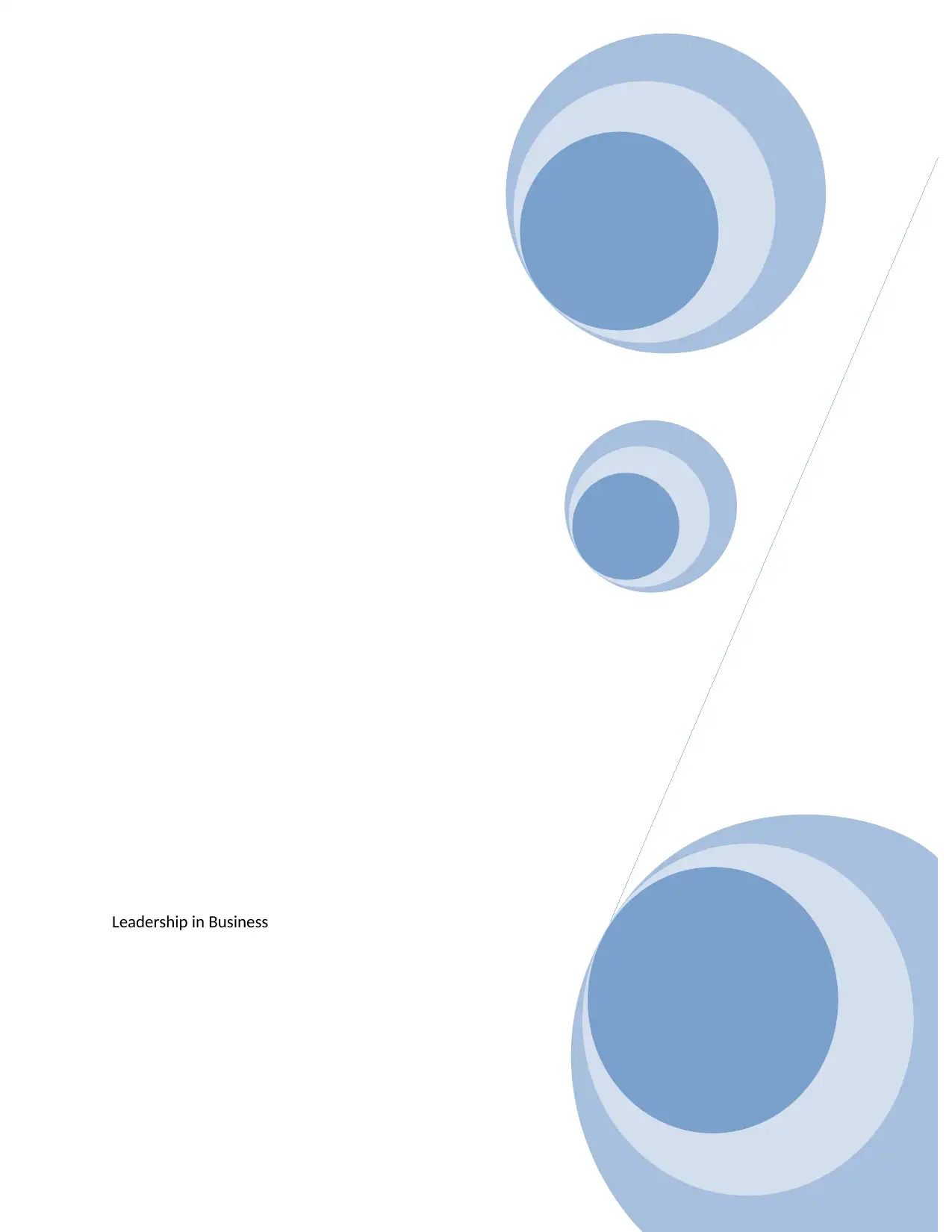
Leadership in Business
Paraphrase This Document
Need a fresh take? Get an instant paraphrase of this document with our AI Paraphraser
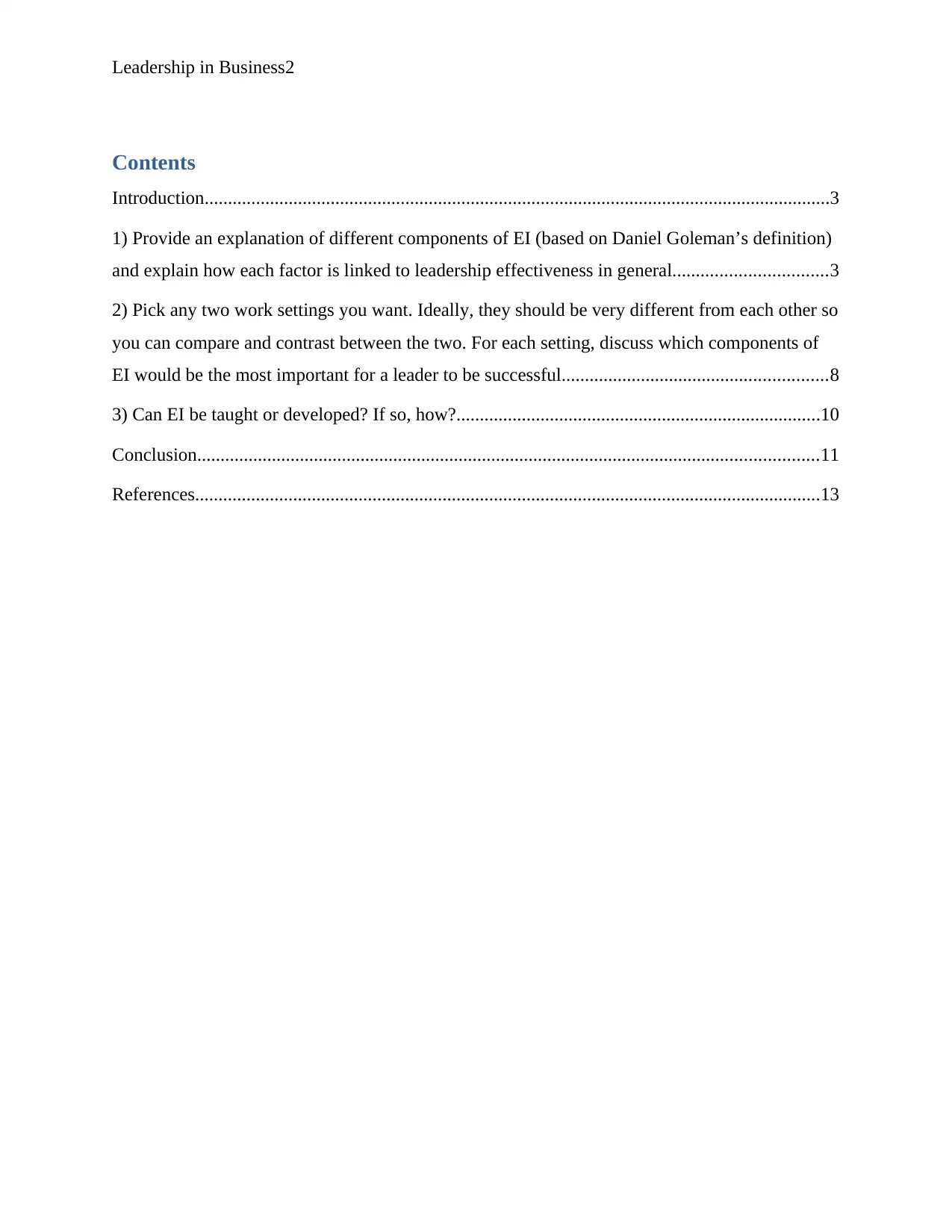
Leadership in Business2
Contents
Introduction......................................................................................................................................3
1) Provide an explanation of different components of EI (based on Daniel Goleman’s definition)
and explain how each factor is linked to leadership effectiveness in general.................................3
2) Pick any two work settings you want. Ideally, they should be very different from each other so
you can compare and contrast between the two. For each setting, discuss which components of
EI would be the most important for a leader to be successful.........................................................8
3) Can EI be taught or developed? If so, how?..............................................................................10
Conclusion.....................................................................................................................................11
References......................................................................................................................................13
Contents
Introduction......................................................................................................................................3
1) Provide an explanation of different components of EI (based on Daniel Goleman’s definition)
and explain how each factor is linked to leadership effectiveness in general.................................3
2) Pick any two work settings you want. Ideally, they should be very different from each other so
you can compare and contrast between the two. For each setting, discuss which components of
EI would be the most important for a leader to be successful.........................................................8
3) Can EI be taught or developed? If so, how?..............................................................................10
Conclusion.....................................................................................................................................11
References......................................................................................................................................13
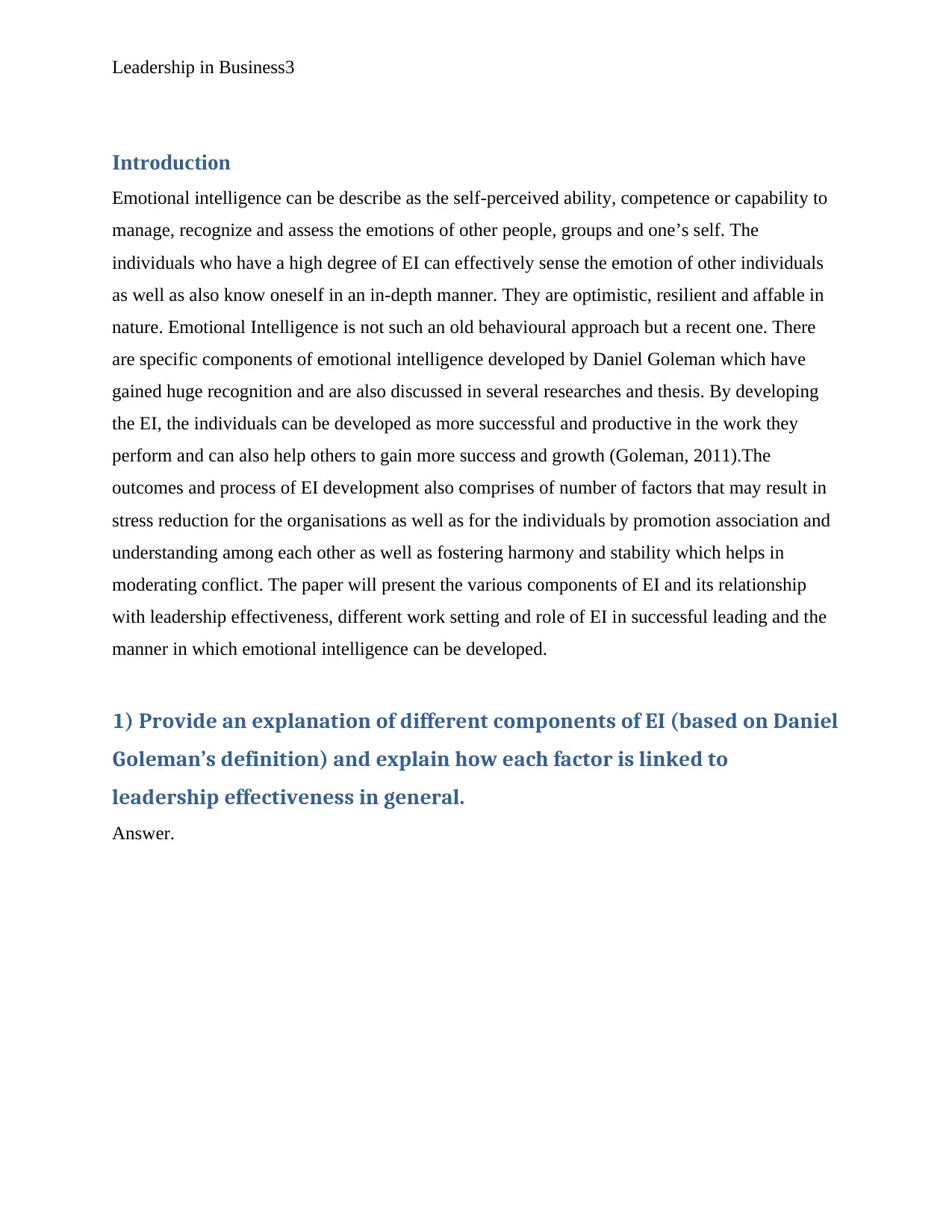
Leadership in Business3
Introduction
Emotional intelligence can be describe as the self-perceived ability, competence or capability to
manage, recognize and assess the emotions of other people, groups and one’s self. The
individuals who have a high degree of EI can effectively sense the emotion of other individuals
as well as also know oneself in an in-depth manner. They are optimistic, resilient and affable in
nature. Emotional Intelligence is not such an old behavioural approach but a recent one. There
are specific components of emotional intelligence developed by Daniel Goleman which have
gained huge recognition and are also discussed in several researches and thesis. By developing
the EI, the individuals can be developed as more successful and productive in the work they
perform and can also help others to gain more success and growth (Goleman, 2011).The
outcomes and process of EI development also comprises of number of factors that may result in
stress reduction for the organisations as well as for the individuals by promotion association and
understanding among each other as well as fostering harmony and stability which helps in
moderating conflict. The paper will present the various components of EI and its relationship
with leadership effectiveness, different work setting and role of EI in successful leading and the
manner in which emotional intelligence can be developed.
1) Provide an explanation of different components of EI (based on Daniel
Goleman’s definition) and explain how each factor is linked to
leadership effectiveness in general.
Answer.
Introduction
Emotional intelligence can be describe as the self-perceived ability, competence or capability to
manage, recognize and assess the emotions of other people, groups and one’s self. The
individuals who have a high degree of EI can effectively sense the emotion of other individuals
as well as also know oneself in an in-depth manner. They are optimistic, resilient and affable in
nature. Emotional Intelligence is not such an old behavioural approach but a recent one. There
are specific components of emotional intelligence developed by Daniel Goleman which have
gained huge recognition and are also discussed in several researches and thesis. By developing
the EI, the individuals can be developed as more successful and productive in the work they
perform and can also help others to gain more success and growth (Goleman, 2011).The
outcomes and process of EI development also comprises of number of factors that may result in
stress reduction for the organisations as well as for the individuals by promotion association and
understanding among each other as well as fostering harmony and stability which helps in
moderating conflict. The paper will present the various components of EI and its relationship
with leadership effectiveness, different work setting and role of EI in successful leading and the
manner in which emotional intelligence can be developed.
1) Provide an explanation of different components of EI (based on Daniel
Goleman’s definition) and explain how each factor is linked to
leadership effectiveness in general.
Answer.
⊘ This is a preview!⊘
Do you want full access?
Subscribe today to unlock all pages.

Trusted by 1+ million students worldwide
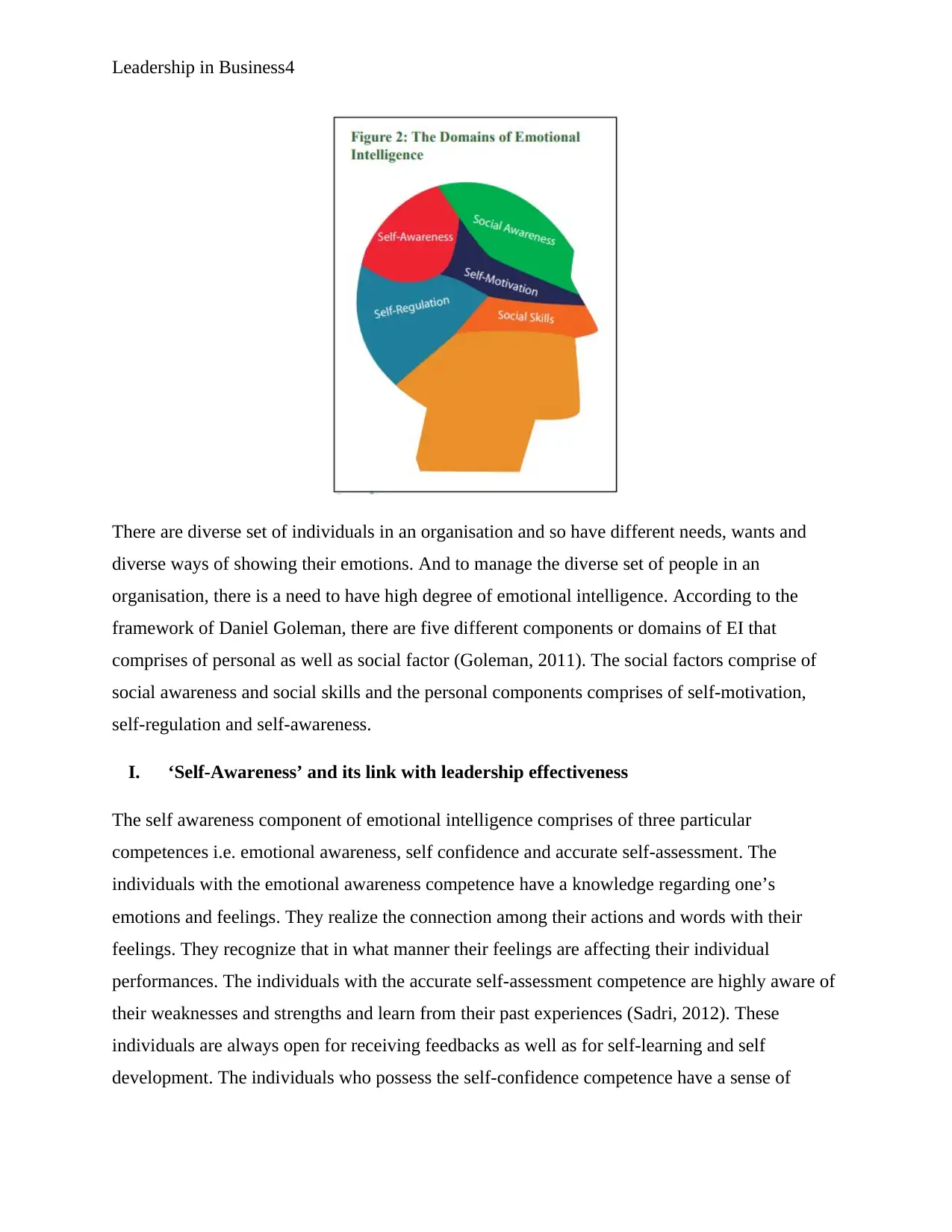
Leadership in Business4
There are diverse set of individuals in an organisation and so have different needs, wants and
diverse ways of showing their emotions. And to manage the diverse set of people in an
organisation, there is a need to have high degree of emotional intelligence. According to the
framework of Daniel Goleman, there are five different components or domains of EI that
comprises of personal as well as social factor (Goleman, 2011). The social factors comprise of
social awareness and social skills and the personal components comprises of self-motivation,
self-regulation and self-awareness.
I. ‘Self-Awareness’ and its link with leadership effectiveness
The self awareness component of emotional intelligence comprises of three particular
competences i.e. emotional awareness, self confidence and accurate self-assessment. The
individuals with the emotional awareness competence have a knowledge regarding one’s
emotions and feelings. They realize the connection among their actions and words with their
feelings. They recognize that in what manner their feelings are affecting their individual
performances. The individuals with the accurate self-assessment competence are highly aware of
their weaknesses and strengths and learn from their past experiences (Sadri, 2012). These
individuals are always open for receiving feedbacks as well as for self-learning and self
development. The individuals who possess the self-confidence competence have a sense of
There are diverse set of individuals in an organisation and so have different needs, wants and
diverse ways of showing their emotions. And to manage the diverse set of people in an
organisation, there is a need to have high degree of emotional intelligence. According to the
framework of Daniel Goleman, there are five different components or domains of EI that
comprises of personal as well as social factor (Goleman, 2011). The social factors comprise of
social awareness and social skills and the personal components comprises of self-motivation,
self-regulation and self-awareness.
I. ‘Self-Awareness’ and its link with leadership effectiveness
The self awareness component of emotional intelligence comprises of three particular
competences i.e. emotional awareness, self confidence and accurate self-assessment. The
individuals with the emotional awareness competence have a knowledge regarding one’s
emotions and feelings. They realize the connection among their actions and words with their
feelings. They recognize that in what manner their feelings are affecting their individual
performances. The individuals with the accurate self-assessment competence are highly aware of
their weaknesses and strengths and learn from their past experiences (Sadri, 2012). These
individuals are always open for receiving feedbacks as well as for self-learning and self
development. The individuals who possess the self-confidence competence have a sense of
Paraphrase This Document
Need a fresh take? Get an instant paraphrase of this document with our AI Paraphraser
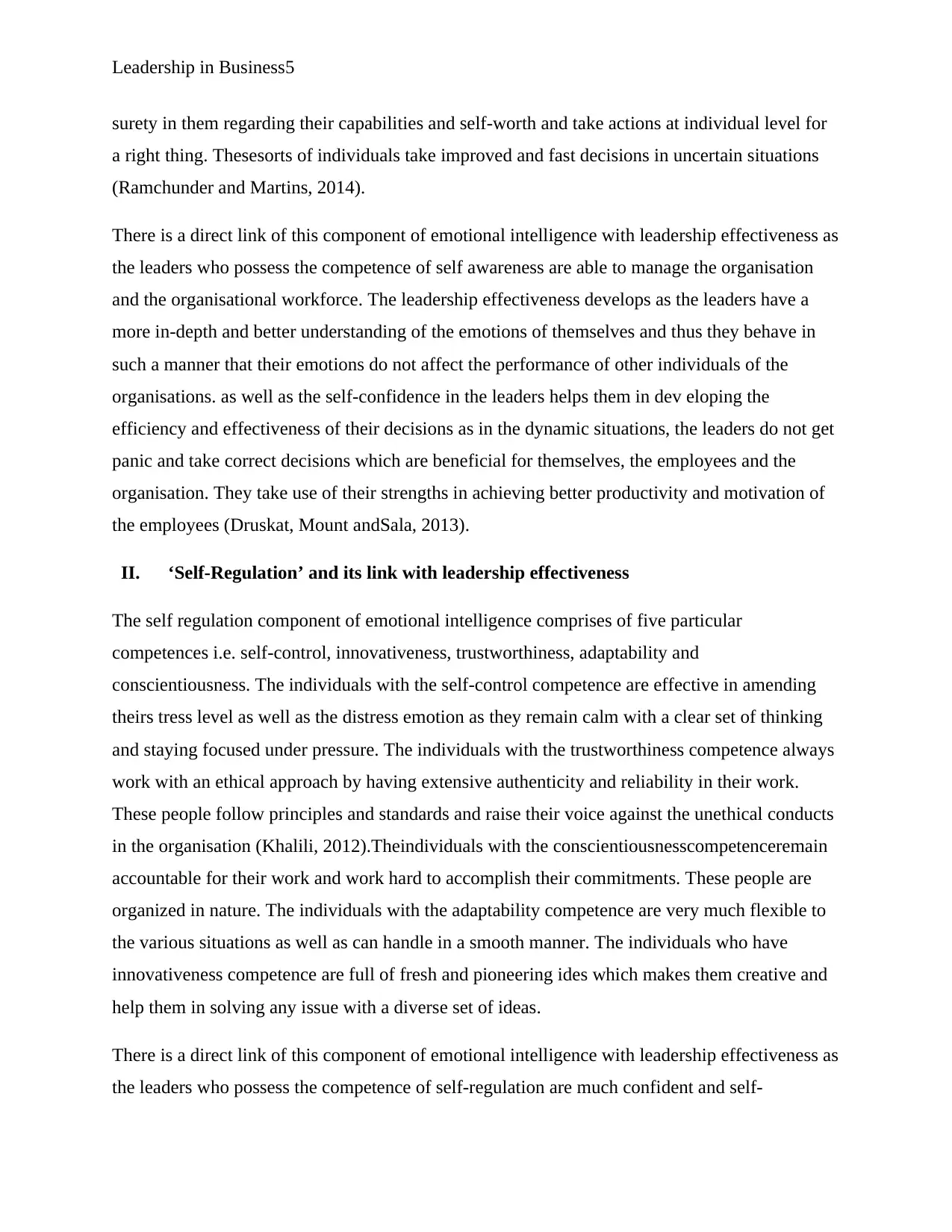
Leadership in Business5
surety in them regarding their capabilities and self-worth and take actions at individual level for
a right thing. Thesesorts of individuals take improved and fast decisions in uncertain situations
(Ramchunder and Martins, 2014).
There is a direct link of this component of emotional intelligence with leadership effectiveness as
the leaders who possess the competence of self awareness are able to manage the organisation
and the organisational workforce. The leadership effectiveness develops as the leaders have a
more in-depth and better understanding of the emotions of themselves and thus they behave in
such a manner that their emotions do not affect the performance of other individuals of the
organisations. as well as the self-confidence in the leaders helps them in dev eloping the
efficiency and effectiveness of their decisions as in the dynamic situations, the leaders do not get
panic and take correct decisions which are beneficial for themselves, the employees and the
organisation. They take use of their strengths in achieving better productivity and motivation of
the employees (Druskat, Mount andSala, 2013).
II. ‘Self-Regulation’ and its link with leadership effectiveness
The self regulation component of emotional intelligence comprises of five particular
competences i.e. self-control, innovativeness, trustworthiness, adaptability and
conscientiousness. The individuals with the self-control competence are effective in amending
theirs tress level as well as the distress emotion as they remain calm with a clear set of thinking
and staying focused under pressure. The individuals with the trustworthiness competence always
work with an ethical approach by having extensive authenticity and reliability in their work.
These people follow principles and standards and raise their voice against the unethical conducts
in the organisation (Khalili, 2012).Theindividuals with the conscientiousnesscompetenceremain
accountable for their work and work hard to accomplish their commitments. These people are
organized in nature. The individuals with the adaptability competence are very much flexible to
the various situations as well as can handle in a smooth manner. The individuals who have
innovativeness competence are full of fresh and pioneering ides which makes them creative and
help them in solving any issue with a diverse set of ideas.
There is a direct link of this component of emotional intelligence with leadership effectiveness as
the leaders who possess the competence of self-regulation are much confident and self-
surety in them regarding their capabilities and self-worth and take actions at individual level for
a right thing. Thesesorts of individuals take improved and fast decisions in uncertain situations
(Ramchunder and Martins, 2014).
There is a direct link of this component of emotional intelligence with leadership effectiveness as
the leaders who possess the competence of self awareness are able to manage the organisation
and the organisational workforce. The leadership effectiveness develops as the leaders have a
more in-depth and better understanding of the emotions of themselves and thus they behave in
such a manner that their emotions do not affect the performance of other individuals of the
organisations. as well as the self-confidence in the leaders helps them in dev eloping the
efficiency and effectiveness of their decisions as in the dynamic situations, the leaders do not get
panic and take correct decisions which are beneficial for themselves, the employees and the
organisation. They take use of their strengths in achieving better productivity and motivation of
the employees (Druskat, Mount andSala, 2013).
II. ‘Self-Regulation’ and its link with leadership effectiveness
The self regulation component of emotional intelligence comprises of five particular
competences i.e. self-control, innovativeness, trustworthiness, adaptability and
conscientiousness. The individuals with the self-control competence are effective in amending
theirs tress level as well as the distress emotion as they remain calm with a clear set of thinking
and staying focused under pressure. The individuals with the trustworthiness competence always
work with an ethical approach by having extensive authenticity and reliability in their work.
These people follow principles and standards and raise their voice against the unethical conducts
in the organisation (Khalili, 2012).Theindividuals with the conscientiousnesscompetenceremain
accountable for their work and work hard to accomplish their commitments. These people are
organized in nature. The individuals with the adaptability competence are very much flexible to
the various situations as well as can handle in a smooth manner. The individuals who have
innovativeness competence are full of fresh and pioneering ides which makes them creative and
help them in solving any issue with a diverse set of ideas.
There is a direct link of this component of emotional intelligence with leadership effectiveness as
the leaders who possess the competence of self-regulation are much confident and self-
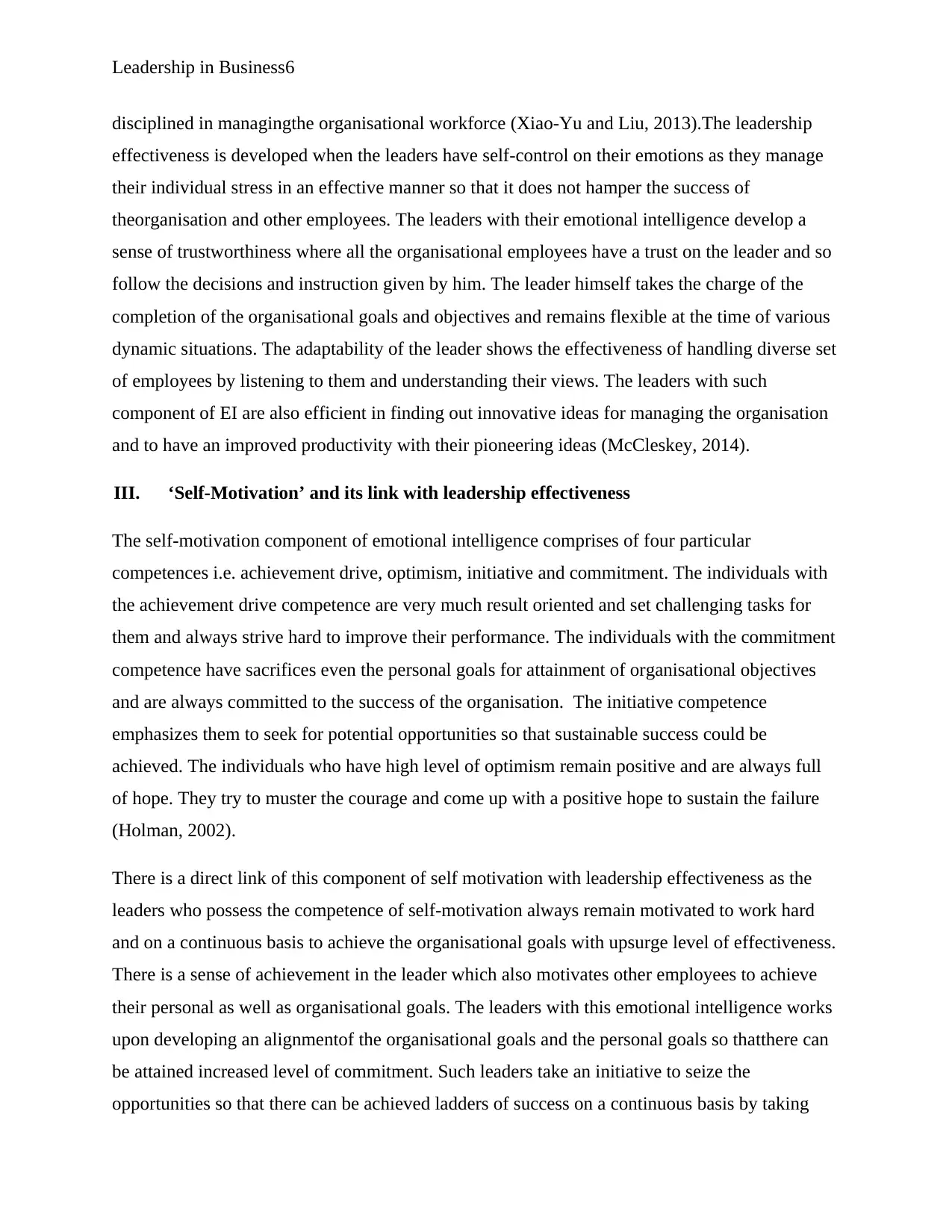
Leadership in Business6
disciplined in managingthe organisational workforce (Xiao-Yu and Liu, 2013).The leadership
effectiveness is developed when the leaders have self-control on their emotions as they manage
their individual stress in an effective manner so that it does not hamper the success of
theorganisation and other employees. The leaders with their emotional intelligence develop a
sense of trustworthiness where all the organisational employees have a trust on the leader and so
follow the decisions and instruction given by him. The leader himself takes the charge of the
completion of the organisational goals and objectives and remains flexible at the time of various
dynamic situations. The adaptability of the leader shows the effectiveness of handling diverse set
of employees by listening to them and understanding their views. The leaders with such
component of EI are also efficient in finding out innovative ideas for managing the organisation
and to have an improved productivity with their pioneering ideas (McCleskey, 2014).
III. ‘Self-Motivation’ and its link with leadership effectiveness
The self-motivation component of emotional intelligence comprises of four particular
competences i.e. achievement drive, optimism, initiative and commitment. The individuals with
the achievement drive competence are very much result oriented and set challenging tasks for
them and always strive hard to improve their performance. The individuals with the commitment
competence have sacrifices even the personal goals for attainment of organisational objectives
and are always committed to the success of the organisation. The initiative competence
emphasizes them to seek for potential opportunities so that sustainable success could be
achieved. The individuals who have high level of optimism remain positive and are always full
of hope. They try to muster the courage and come up with a positive hope to sustain the failure
(Holman, 2002).
There is a direct link of this component of self motivation with leadership effectiveness as the
leaders who possess the competence of self-motivation always remain motivated to work hard
and on a continuous basis to achieve the organisational goals with upsurge level of effectiveness.
There is a sense of achievement in the leader which also motivates other employees to achieve
their personal as well as organisational goals. The leaders with this emotional intelligence works
upon developing an alignmentof the organisational goals and the personal goals so thatthere can
be attained increased level of commitment. Such leaders take an initiative to seize the
opportunities so that there can be achieved ladders of success on a continuous basis by taking
disciplined in managingthe organisational workforce (Xiao-Yu and Liu, 2013).The leadership
effectiveness is developed when the leaders have self-control on their emotions as they manage
their individual stress in an effective manner so that it does not hamper the success of
theorganisation and other employees. The leaders with their emotional intelligence develop a
sense of trustworthiness where all the organisational employees have a trust on the leader and so
follow the decisions and instruction given by him. The leader himself takes the charge of the
completion of the organisational goals and objectives and remains flexible at the time of various
dynamic situations. The adaptability of the leader shows the effectiveness of handling diverse set
of employees by listening to them and understanding their views. The leaders with such
component of EI are also efficient in finding out innovative ideas for managing the organisation
and to have an improved productivity with their pioneering ideas (McCleskey, 2014).
III. ‘Self-Motivation’ and its link with leadership effectiveness
The self-motivation component of emotional intelligence comprises of four particular
competences i.e. achievement drive, optimism, initiative and commitment. The individuals with
the achievement drive competence are very much result oriented and set challenging tasks for
them and always strive hard to improve their performance. The individuals with the commitment
competence have sacrifices even the personal goals for attainment of organisational objectives
and are always committed to the success of the organisation. The initiative competence
emphasizes them to seek for potential opportunities so that sustainable success could be
achieved. The individuals who have high level of optimism remain positive and are always full
of hope. They try to muster the courage and come up with a positive hope to sustain the failure
(Holman, 2002).
There is a direct link of this component of self motivation with leadership effectiveness as the
leaders who possess the competence of self-motivation always remain motivated to work hard
and on a continuous basis to achieve the organisational goals with upsurge level of effectiveness.
There is a sense of achievement in the leader which also motivates other employees to achieve
their personal as well as organisational goals. The leaders with this emotional intelligence works
upon developing an alignmentof the organisational goals and the personal goals so thatthere can
be attained increased level of commitment. Such leaders take an initiative to seize the
opportunities so that there can be achieved ladders of success on a continuous basis by taking
⊘ This is a preview!⊘
Do you want full access?
Subscribe today to unlock all pages.

Trusted by 1+ million students worldwide
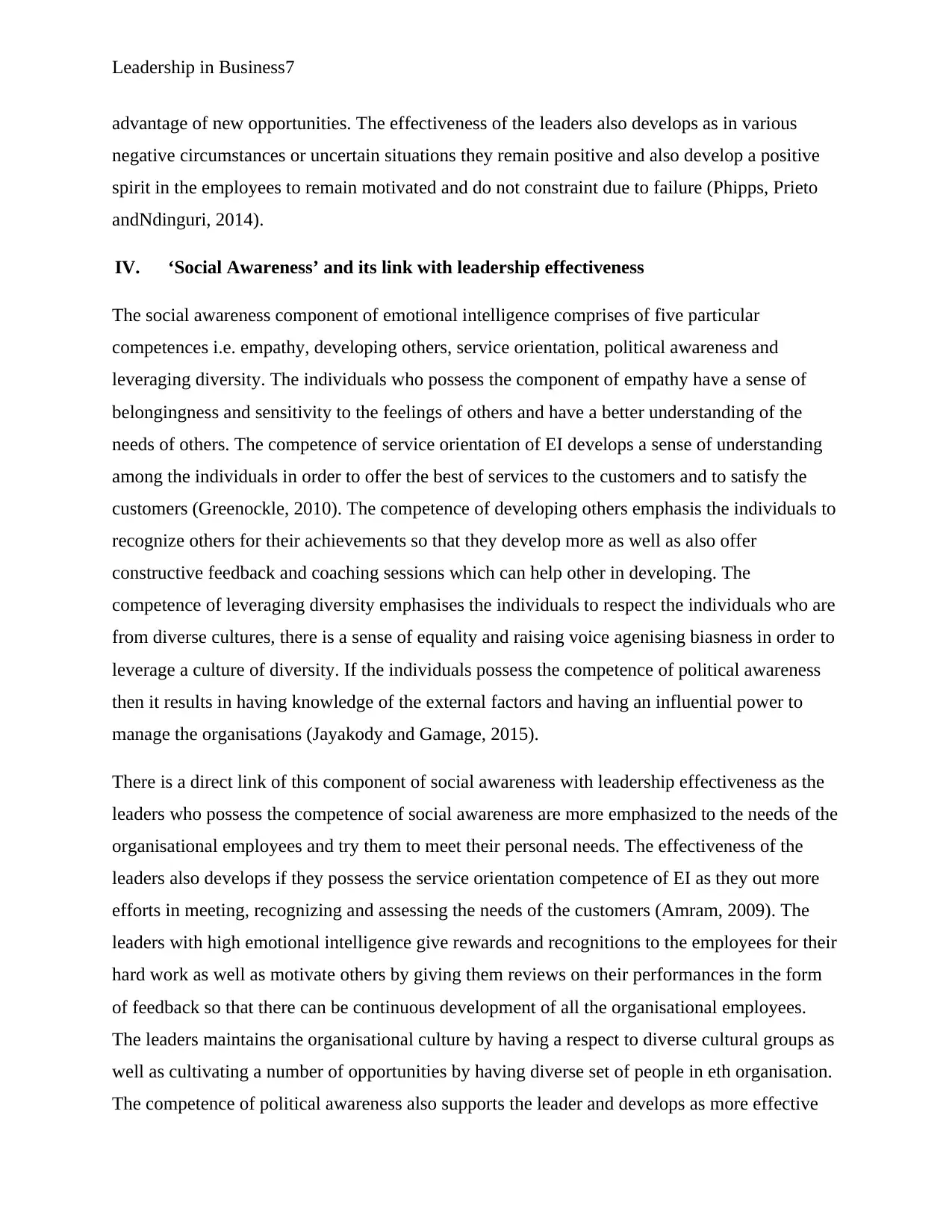
Leadership in Business7
advantage of new opportunities. The effectiveness of the leaders also develops as in various
negative circumstances or uncertain situations they remain positive and also develop a positive
spirit in the employees to remain motivated and do not constraint due to failure (Phipps, Prieto
andNdinguri, 2014).
IV. ‘Social Awareness’ and its link with leadership effectiveness
The social awareness component of emotional intelligence comprises of five particular
competences i.e. empathy, developing others, service orientation, political awareness and
leveraging diversity. The individuals who possess the component of empathy have a sense of
belongingness and sensitivity to the feelings of others and have a better understanding of the
needs of others. The competence of service orientation of EI develops a sense of understanding
among the individuals in order to offer the best of services to the customers and to satisfy the
customers (Greenockle, 2010). The competence of developing others emphasis the individuals to
recognize others for their achievements so that they develop more as well as also offer
constructive feedback and coaching sessions which can help other in developing. The
competence of leveraging diversity emphasises the individuals to respect the individuals who are
from diverse cultures, there is a sense of equality and raising voice agenising biasness in order to
leverage a culture of diversity. If the individuals possess the competence of political awareness
then it results in having knowledge of the external factors and having an influential power to
manage the organisations (Jayakody and Gamage, 2015).
There is a direct link of this component of social awareness with leadership effectiveness as the
leaders who possess the competence of social awareness are more emphasized to the needs of the
organisational employees and try them to meet their personal needs. The effectiveness of the
leaders also develops if they possess the service orientation competence of EI as they out more
efforts in meeting, recognizing and assessing the needs of the customers (Amram, 2009). The
leaders with high emotional intelligence give rewards and recognitions to the employees for their
hard work as well as motivate others by giving them reviews on their performances in the form
of feedback so that there can be continuous development of all the organisational employees.
The leaders maintains the organisational culture by having a respect to diverse cultural groups as
well as cultivating a number of opportunities by having diverse set of people in eth organisation.
The competence of political awareness also supports the leader and develops as more effective
advantage of new opportunities. The effectiveness of the leaders also develops as in various
negative circumstances or uncertain situations they remain positive and also develop a positive
spirit in the employees to remain motivated and do not constraint due to failure (Phipps, Prieto
andNdinguri, 2014).
IV. ‘Social Awareness’ and its link with leadership effectiveness
The social awareness component of emotional intelligence comprises of five particular
competences i.e. empathy, developing others, service orientation, political awareness and
leveraging diversity. The individuals who possess the component of empathy have a sense of
belongingness and sensitivity to the feelings of others and have a better understanding of the
needs of others. The competence of service orientation of EI develops a sense of understanding
among the individuals in order to offer the best of services to the customers and to satisfy the
customers (Greenockle, 2010). The competence of developing others emphasis the individuals to
recognize others for their achievements so that they develop more as well as also offer
constructive feedback and coaching sessions which can help other in developing. The
competence of leveraging diversity emphasises the individuals to respect the individuals who are
from diverse cultures, there is a sense of equality and raising voice agenising biasness in order to
leverage a culture of diversity. If the individuals possess the competence of political awareness
then it results in having knowledge of the external factors and having an influential power to
manage the organisations (Jayakody and Gamage, 2015).
There is a direct link of this component of social awareness with leadership effectiveness as the
leaders who possess the competence of social awareness are more emphasized to the needs of the
organisational employees and try them to meet their personal needs. The effectiveness of the
leaders also develops if they possess the service orientation competence of EI as they out more
efforts in meeting, recognizing and assessing the needs of the customers (Amram, 2009). The
leaders with high emotional intelligence give rewards and recognitions to the employees for their
hard work as well as motivate others by giving them reviews on their performances in the form
of feedback so that there can be continuous development of all the organisational employees.
The leaders maintains the organisational culture by having a respect to diverse cultural groups as
well as cultivating a number of opportunities by having diverse set of people in eth organisation.
The competence of political awareness also supports the leader and develops as more effective
Paraphrase This Document
Need a fresh take? Get an instant paraphrase of this document with our AI Paraphraser
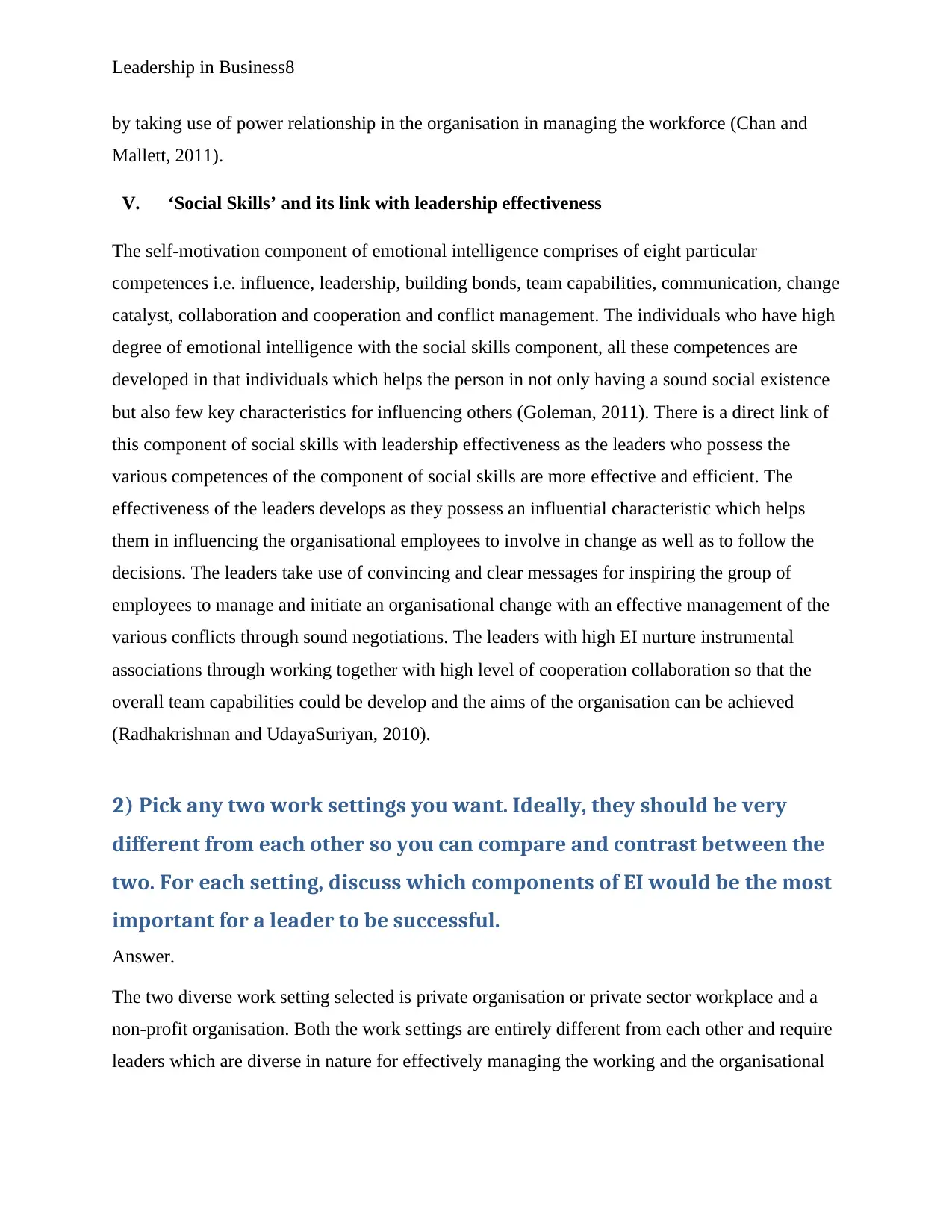
Leadership in Business8
by taking use of power relationship in the organisation in managing the workforce (Chan and
Mallett, 2011).
V. ‘Social Skills’ and its link with leadership effectiveness
The self-motivation component of emotional intelligence comprises of eight particular
competences i.e. influence, leadership, building bonds, team capabilities, communication, change
catalyst, collaboration and cooperation and conflict management. The individuals who have high
degree of emotional intelligence with the social skills component, all these competences are
developed in that individuals which helps the person in not only having a sound social existence
but also few key characteristics for influencing others (Goleman, 2011). There is a direct link of
this component of social skills with leadership effectiveness as the leaders who possess the
various competences of the component of social skills are more effective and efficient. The
effectiveness of the leaders develops as they possess an influential characteristic which helps
them in influencing the organisational employees to involve in change as well as to follow the
decisions. The leaders take use of convincing and clear messages for inspiring the group of
employees to manage and initiate an organisational change with an effective management of the
various conflicts through sound negotiations. The leaders with high EI nurture instrumental
associations through working together with high level of cooperation collaboration so that the
overall team capabilities could be develop and the aims of the organisation can be achieved
(Radhakrishnan and UdayaSuriyan, 2010).
2) Pick any two work settings you want. Ideally, they should be very
different from each other so you can compare and contrast between the
two. For each setting, discuss which components of EI would be the most
important for a leader to be successful.
Answer.
The two diverse work setting selected is private organisation or private sector workplace and a
non-profit organisation. Both the work settings are entirely different from each other and require
leaders which are diverse in nature for effectively managing the working and the organisational
by taking use of power relationship in the organisation in managing the workforce (Chan and
Mallett, 2011).
V. ‘Social Skills’ and its link with leadership effectiveness
The self-motivation component of emotional intelligence comprises of eight particular
competences i.e. influence, leadership, building bonds, team capabilities, communication, change
catalyst, collaboration and cooperation and conflict management. The individuals who have high
degree of emotional intelligence with the social skills component, all these competences are
developed in that individuals which helps the person in not only having a sound social existence
but also few key characteristics for influencing others (Goleman, 2011). There is a direct link of
this component of social skills with leadership effectiveness as the leaders who possess the
various competences of the component of social skills are more effective and efficient. The
effectiveness of the leaders develops as they possess an influential characteristic which helps
them in influencing the organisational employees to involve in change as well as to follow the
decisions. The leaders take use of convincing and clear messages for inspiring the group of
employees to manage and initiate an organisational change with an effective management of the
various conflicts through sound negotiations. The leaders with high EI nurture instrumental
associations through working together with high level of cooperation collaboration so that the
overall team capabilities could be develop and the aims of the organisation can be achieved
(Radhakrishnan and UdayaSuriyan, 2010).
2) Pick any two work settings you want. Ideally, they should be very
different from each other so you can compare and contrast between the
two. For each setting, discuss which components of EI would be the most
important for a leader to be successful.
Answer.
The two diverse work setting selected is private organisation or private sector workplace and a
non-profit organisation. Both the work settings are entirely different from each other and require
leaders which are diverse in nature for effectively managing the working and the organisational
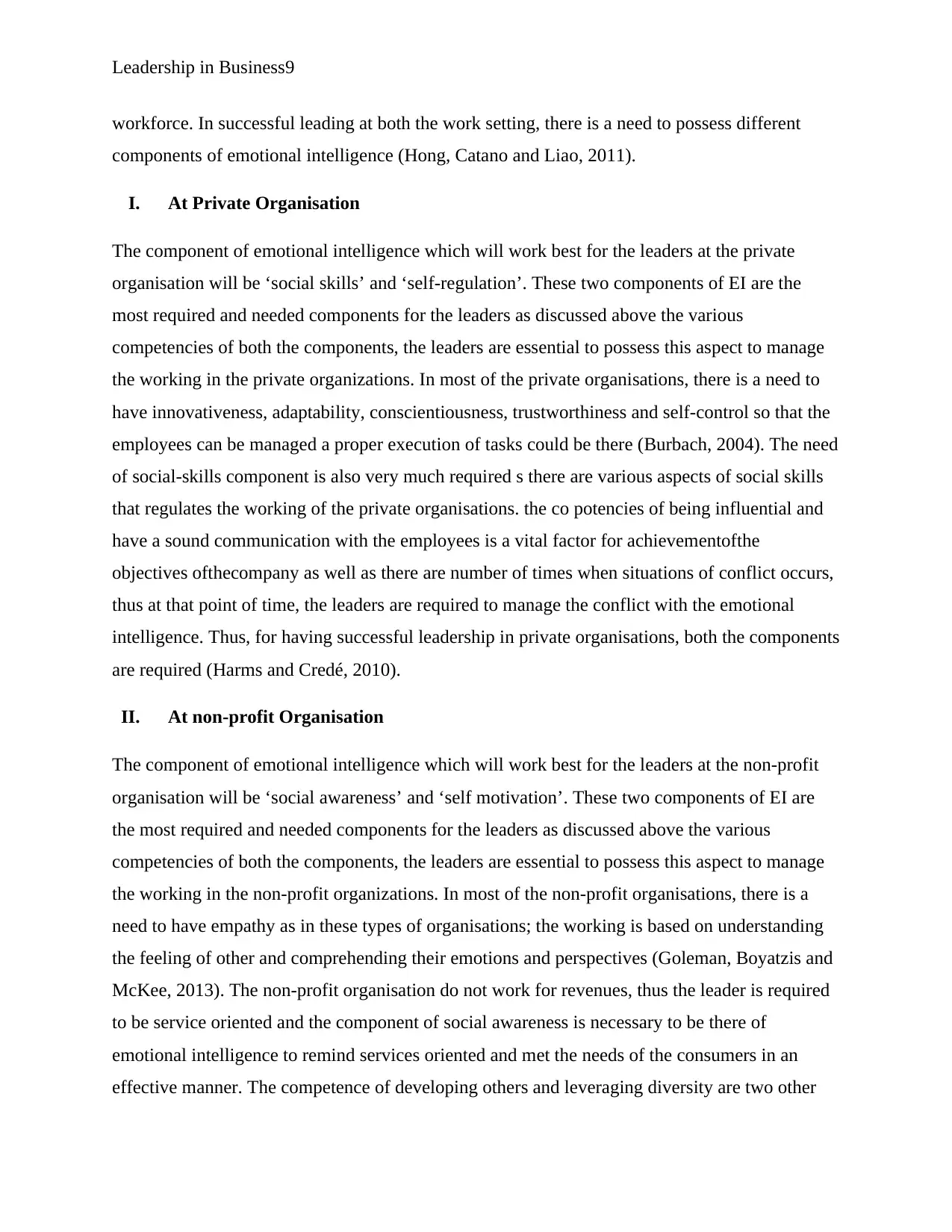
Leadership in Business9
workforce. In successful leading at both the work setting, there is a need to possess different
components of emotional intelligence (Hong, Catano and Liao, 2011).
I. At Private Organisation
The component of emotional intelligence which will work best for the leaders at the private
organisation will be ‘social skills’ and ‘self-regulation’. These two components of EI are the
most required and needed components for the leaders as discussed above the various
competencies of both the components, the leaders are essential to possess this aspect to manage
the working in the private organizations. In most of the private organisations, there is a need to
have innovativeness, adaptability, conscientiousness, trustworthiness and self-control so that the
employees can be managed a proper execution of tasks could be there (Burbach, 2004). The need
of social-skills component is also very much required s there are various aspects of social skills
that regulates the working of the private organisations. the co potencies of being influential and
have a sound communication with the employees is a vital factor for achievementofthe
objectives ofthecompany as well as there are number of times when situations of conflict occurs,
thus at that point of time, the leaders are required to manage the conflict with the emotional
intelligence. Thus, for having successful leadership in private organisations, both the components
are required (Harms and Credé, 2010).
II. At non-profit Organisation
The component of emotional intelligence which will work best for the leaders at the non-profit
organisation will be ‘social awareness’ and ‘self motivation’. These two components of EI are
the most required and needed components for the leaders as discussed above the various
competencies of both the components, the leaders are essential to possess this aspect to manage
the working in the non-profit organizations. In most of the non-profit organisations, there is a
need to have empathy as in these types of organisations; the working is based on understanding
the feeling of other and comprehending their emotions and perspectives (Goleman, Boyatzis and
McKee, 2013). The non-profit organisation do not work for revenues, thus the leader is required
to be service oriented and the component of social awareness is necessary to be there of
emotional intelligence to remind services oriented and met the needs of the consumers in an
effective manner. The competence of developing others and leveraging diversity are two other
workforce. In successful leading at both the work setting, there is a need to possess different
components of emotional intelligence (Hong, Catano and Liao, 2011).
I. At Private Organisation
The component of emotional intelligence which will work best for the leaders at the private
organisation will be ‘social skills’ and ‘self-regulation’. These two components of EI are the
most required and needed components for the leaders as discussed above the various
competencies of both the components, the leaders are essential to possess this aspect to manage
the working in the private organizations. In most of the private organisations, there is a need to
have innovativeness, adaptability, conscientiousness, trustworthiness and self-control so that the
employees can be managed a proper execution of tasks could be there (Burbach, 2004). The need
of social-skills component is also very much required s there are various aspects of social skills
that regulates the working of the private organisations. the co potencies of being influential and
have a sound communication with the employees is a vital factor for achievementofthe
objectives ofthecompany as well as there are number of times when situations of conflict occurs,
thus at that point of time, the leaders are required to manage the conflict with the emotional
intelligence. Thus, for having successful leadership in private organisations, both the components
are required (Harms and Credé, 2010).
II. At non-profit Organisation
The component of emotional intelligence which will work best for the leaders at the non-profit
organisation will be ‘social awareness’ and ‘self motivation’. These two components of EI are
the most required and needed components for the leaders as discussed above the various
competencies of both the components, the leaders are essential to possess this aspect to manage
the working in the non-profit organizations. In most of the non-profit organisations, there is a
need to have empathy as in these types of organisations; the working is based on understanding
the feeling of other and comprehending their emotions and perspectives (Goleman, Boyatzis and
McKee, 2013). The non-profit organisation do not work for revenues, thus the leader is required
to be service oriented and the component of social awareness is necessary to be there of
emotional intelligence to remind services oriented and met the needs of the consumers in an
effective manner. The competence of developing others and leveraging diversity are two other
⊘ This is a preview!⊘
Do you want full access?
Subscribe today to unlock all pages.

Trusted by 1+ million students worldwide
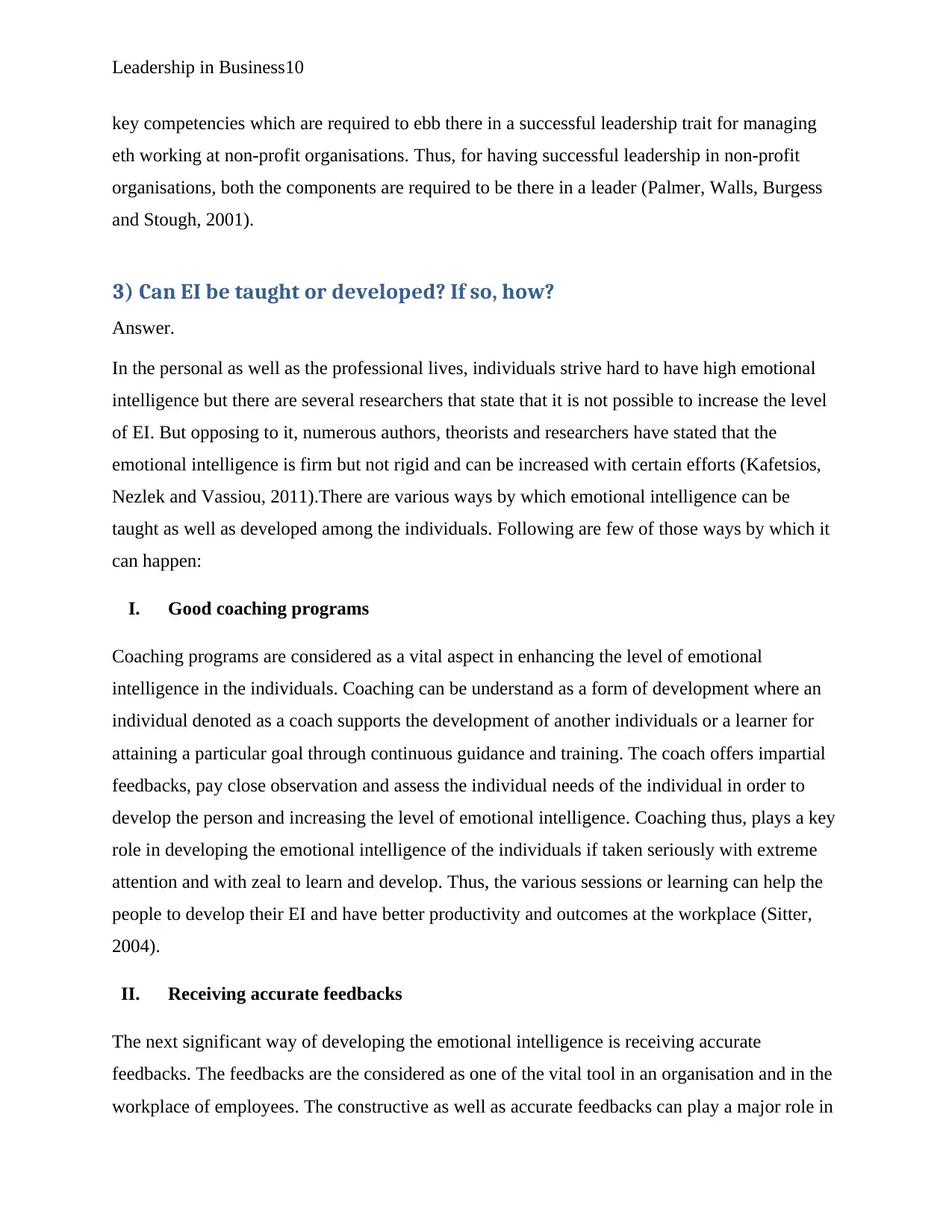
Leadership in Business10
key competencies which are required to ebb there in a successful leadership trait for managing
eth working at non-profit organisations. Thus, for having successful leadership in non-profit
organisations, both the components are required to be there in a leader (Palmer, Walls, Burgess
and Stough, 2001).
3) Can EI be taught or developed? If so, how?
Answer.
In the personal as well as the professional lives, individuals strive hard to have high emotional
intelligence but there are several researchers that state that it is not possible to increase the level
of EI. But opposing to it, numerous authors, theorists and researchers have stated that the
emotional intelligence is firm but not rigid and can be increased with certain efforts (Kafetsios,
Nezlek and Vassiou, 2011).There are various ways by which emotional intelligence can be
taught as well as developed among the individuals. Following are few of those ways by which it
can happen:
I. Good coaching programs
Coaching programs are considered as a vital aspect in enhancing the level of emotional
intelligence in the individuals. Coaching can be understand as a form of development where an
individual denoted as a coach supports the development of another individuals or a learner for
attaining a particular goal through continuous guidance and training. The coach offers impartial
feedbacks, pay close observation and assess the individual needs of the individual in order to
develop the person and increasing the level of emotional intelligence. Coaching thus, plays a key
role in developing the emotional intelligence of the individuals if taken seriously with extreme
attention and with zeal to learn and develop. Thus, the various sessions or learning can help the
people to develop their EI and have better productivity and outcomes at the workplace (Sitter,
2004).
II. Receiving accurate feedbacks
The next significant way of developing the emotional intelligence is receiving accurate
feedbacks. The feedbacks are the considered as one of the vital tool in an organisation and in the
workplace of employees. The constructive as well as accurate feedbacks can play a major role in
key competencies which are required to ebb there in a successful leadership trait for managing
eth working at non-profit organisations. Thus, for having successful leadership in non-profit
organisations, both the components are required to be there in a leader (Palmer, Walls, Burgess
and Stough, 2001).
3) Can EI be taught or developed? If so, how?
Answer.
In the personal as well as the professional lives, individuals strive hard to have high emotional
intelligence but there are several researchers that state that it is not possible to increase the level
of EI. But opposing to it, numerous authors, theorists and researchers have stated that the
emotional intelligence is firm but not rigid and can be increased with certain efforts (Kafetsios,
Nezlek and Vassiou, 2011).There are various ways by which emotional intelligence can be
taught as well as developed among the individuals. Following are few of those ways by which it
can happen:
I. Good coaching programs
Coaching programs are considered as a vital aspect in enhancing the level of emotional
intelligence in the individuals. Coaching can be understand as a form of development where an
individual denoted as a coach supports the development of another individuals or a learner for
attaining a particular goal through continuous guidance and training. The coach offers impartial
feedbacks, pay close observation and assess the individual needs of the individual in order to
develop the person and increasing the level of emotional intelligence. Coaching thus, plays a key
role in developing the emotional intelligence of the individuals if taken seriously with extreme
attention and with zeal to learn and develop. Thus, the various sessions or learning can help the
people to develop their EI and have better productivity and outcomes at the workplace (Sitter,
2004).
II. Receiving accurate feedbacks
The next significant way of developing the emotional intelligence is receiving accurate
feedbacks. The feedbacks are the considered as one of the vital tool in an organisation and in the
workplace of employees. The constructive as well as accurate feedbacks can play a major role in
Paraphrase This Document
Need a fresh take? Get an instant paraphrase of this document with our AI Paraphraser
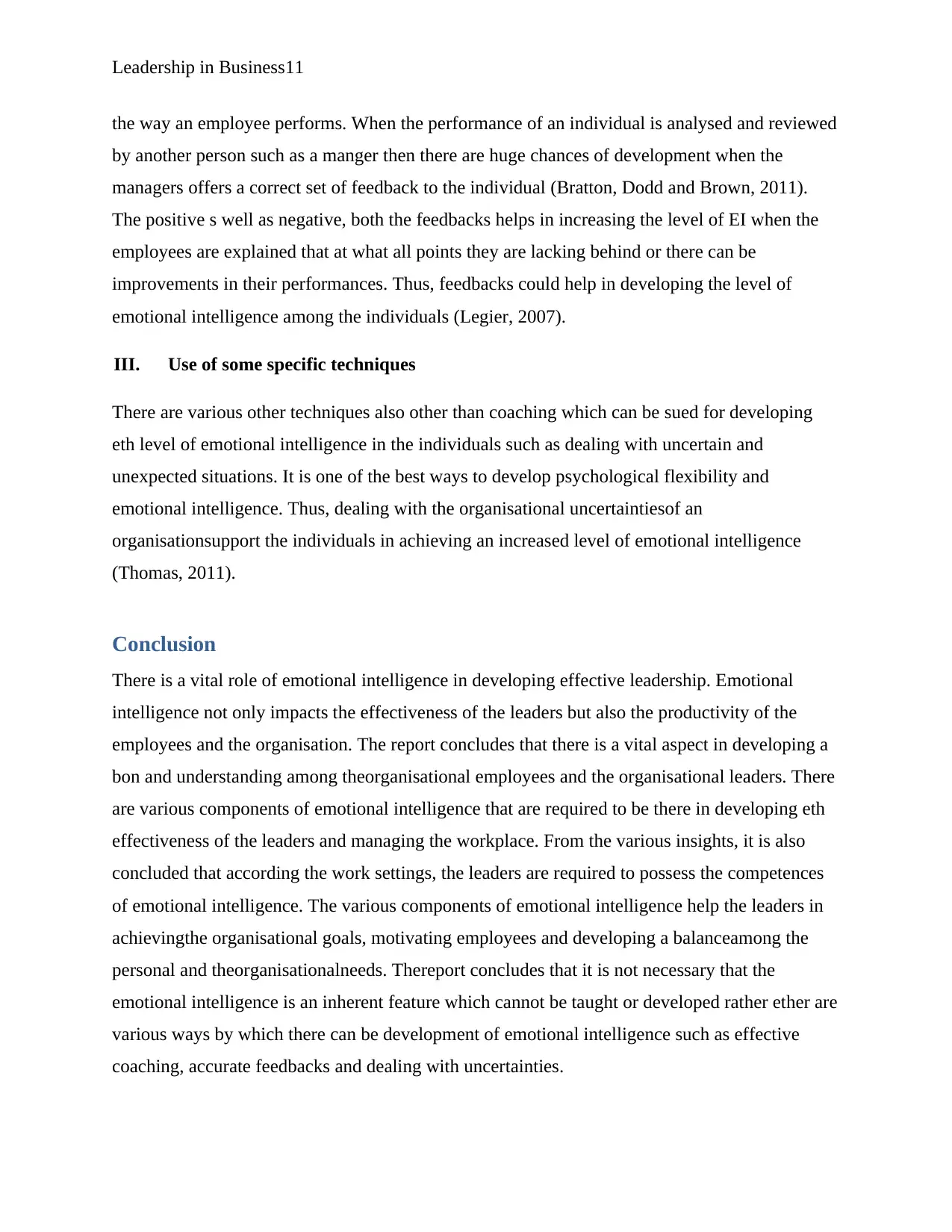
Leadership in Business11
the way an employee performs. When the performance of an individual is analysed and reviewed
by another person such as a manger then there are huge chances of development when the
managers offers a correct set of feedback to the individual (Bratton, Dodd and Brown, 2011).
The positive s well as negative, both the feedbacks helps in increasing the level of EI when the
employees are explained that at what all points they are lacking behind or there can be
improvements in their performances. Thus, feedbacks could help in developing the level of
emotional intelligence among the individuals (Legier, 2007).
III. Use of some specific techniques
There are various other techniques also other than coaching which can be sued for developing
eth level of emotional intelligence in the individuals such as dealing with uncertain and
unexpected situations. It is one of the best ways to develop psychological flexibility and
emotional intelligence. Thus, dealing with the organisational uncertaintiesof an
organisationsupport the individuals in achieving an increased level of emotional intelligence
(Thomas, 2011).
Conclusion
There is a vital role of emotional intelligence in developing effective leadership. Emotional
intelligence not only impacts the effectiveness of the leaders but also the productivity of the
employees and the organisation. The report concludes that there is a vital aspect in developing a
bon and understanding among theorganisational employees and the organisational leaders. There
are various components of emotional intelligence that are required to be there in developing eth
effectiveness of the leaders and managing the workplace. From the various insights, it is also
concluded that according the work settings, the leaders are required to possess the competences
of emotional intelligence. The various components of emotional intelligence help the leaders in
achievingthe organisational goals, motivating employees and developing a balanceamong the
personal and theorganisationalneeds. Thereport concludes that it is not necessary that the
emotional intelligence is an inherent feature which cannot be taught or developed rather ether are
various ways by which there can be development of emotional intelligence such as effective
coaching, accurate feedbacks and dealing with uncertainties.
the way an employee performs. When the performance of an individual is analysed and reviewed
by another person such as a manger then there are huge chances of development when the
managers offers a correct set of feedback to the individual (Bratton, Dodd and Brown, 2011).
The positive s well as negative, both the feedbacks helps in increasing the level of EI when the
employees are explained that at what all points they are lacking behind or there can be
improvements in their performances. Thus, feedbacks could help in developing the level of
emotional intelligence among the individuals (Legier, 2007).
III. Use of some specific techniques
There are various other techniques also other than coaching which can be sued for developing
eth level of emotional intelligence in the individuals such as dealing with uncertain and
unexpected situations. It is one of the best ways to develop psychological flexibility and
emotional intelligence. Thus, dealing with the organisational uncertaintiesof an
organisationsupport the individuals in achieving an increased level of emotional intelligence
(Thomas, 2011).
Conclusion
There is a vital role of emotional intelligence in developing effective leadership. Emotional
intelligence not only impacts the effectiveness of the leaders but also the productivity of the
employees and the organisation. The report concludes that there is a vital aspect in developing a
bon and understanding among theorganisational employees and the organisational leaders. There
are various components of emotional intelligence that are required to be there in developing eth
effectiveness of the leaders and managing the workplace. From the various insights, it is also
concluded that according the work settings, the leaders are required to possess the competences
of emotional intelligence. The various components of emotional intelligence help the leaders in
achievingthe organisational goals, motivating employees and developing a balanceamong the
personal and theorganisationalneeds. Thereport concludes that it is not necessary that the
emotional intelligence is an inherent feature which cannot be taught or developed rather ether are
various ways by which there can be development of emotional intelligence such as effective
coaching, accurate feedbacks and dealing with uncertainties.
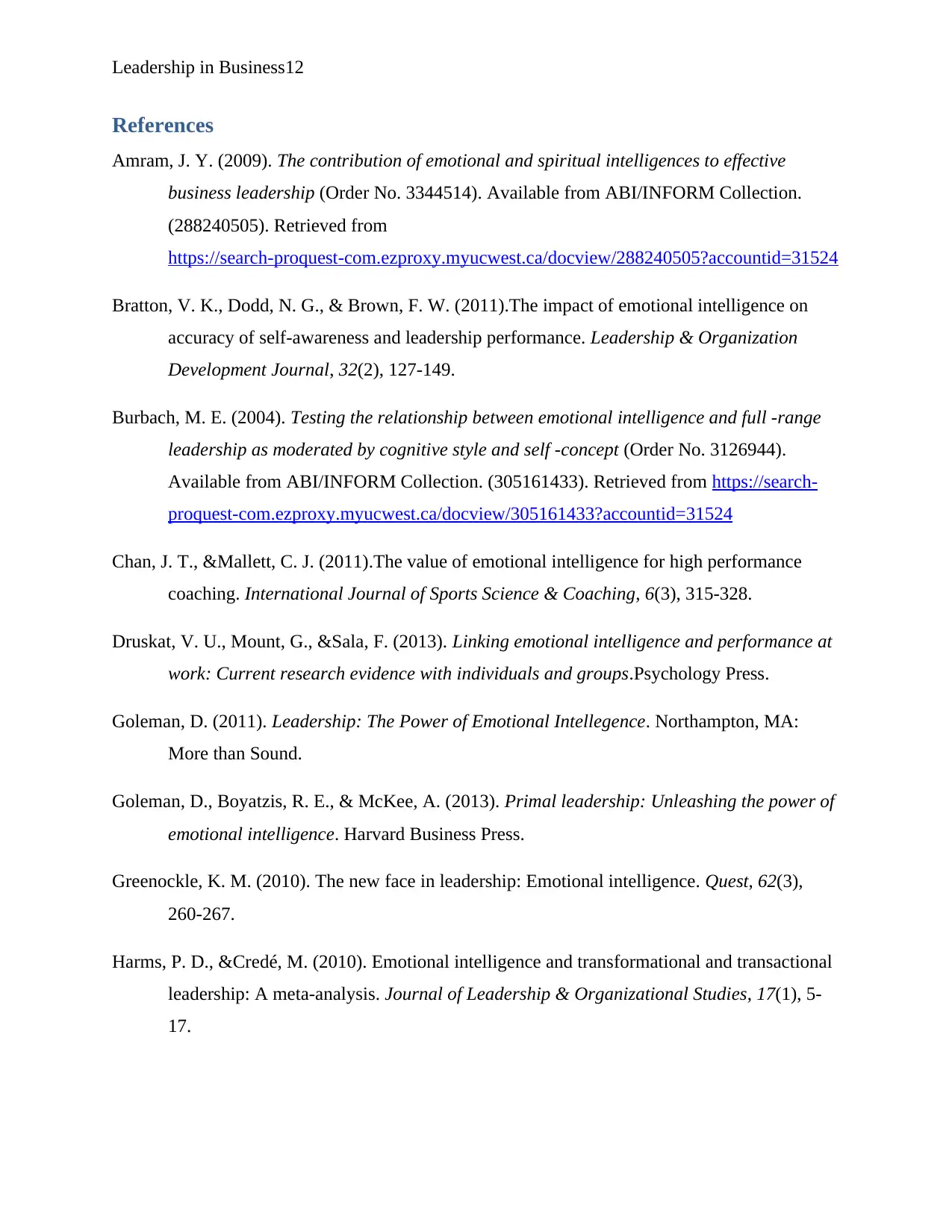
Leadership in Business12
References
Amram, J. Y. (2009). The contribution of emotional and spiritual intelligences to effective
business leadership (Order No. 3344514). Available from ABI/INFORM Collection.
(288240505). Retrieved from
https://search-proquest-com.ezproxy.myucwest.ca/docview/288240505?accountid=31524
Bratton, V. K., Dodd, N. G., & Brown, F. W. (2011).The impact of emotional intelligence on
accuracy of self-awareness and leadership performance. Leadership & Organization
Development Journal, 32(2), 127-149.
Burbach, M. E. (2004). Testing the relationship between emotional intelligence and full -range
leadership as moderated by cognitive style and self -concept (Order No. 3126944).
Available from ABI/INFORM Collection. (305161433). Retrieved from https://search-
proquest-com.ezproxy.myucwest.ca/docview/305161433?accountid=31524
Chan, J. T., &Mallett, C. J. (2011).The value of emotional intelligence for high performance
coaching. International Journal of Sports Science & Coaching, 6(3), 315-328.
Druskat, V. U., Mount, G., &Sala, F. (2013). Linking emotional intelligence and performance at
work: Current research evidence with individuals and groups.Psychology Press.
Goleman, D. (2011). Leadership: The Power of Emotional Intellegence. Northampton, MA:
More than Sound.
Goleman, D., Boyatzis, R. E., & McKee, A. (2013). Primal leadership: Unleashing the power of
emotional intelligence. Harvard Business Press.
Greenockle, K. M. (2010). The new face in leadership: Emotional intelligence. Quest, 62(3),
260-267.
Harms, P. D., &Credé, M. (2010). Emotional intelligence and transformational and transactional
leadership: A meta-analysis. Journal of Leadership & Organizational Studies, 17(1), 5-
17.
References
Amram, J. Y. (2009). The contribution of emotional and spiritual intelligences to effective
business leadership (Order No. 3344514). Available from ABI/INFORM Collection.
(288240505). Retrieved from
https://search-proquest-com.ezproxy.myucwest.ca/docview/288240505?accountid=31524
Bratton, V. K., Dodd, N. G., & Brown, F. W. (2011).The impact of emotional intelligence on
accuracy of self-awareness and leadership performance. Leadership & Organization
Development Journal, 32(2), 127-149.
Burbach, M. E. (2004). Testing the relationship between emotional intelligence and full -range
leadership as moderated by cognitive style and self -concept (Order No. 3126944).
Available from ABI/INFORM Collection. (305161433). Retrieved from https://search-
proquest-com.ezproxy.myucwest.ca/docview/305161433?accountid=31524
Chan, J. T., &Mallett, C. J. (2011).The value of emotional intelligence for high performance
coaching. International Journal of Sports Science & Coaching, 6(3), 315-328.
Druskat, V. U., Mount, G., &Sala, F. (2013). Linking emotional intelligence and performance at
work: Current research evidence with individuals and groups.Psychology Press.
Goleman, D. (2011). Leadership: The Power of Emotional Intellegence. Northampton, MA:
More than Sound.
Goleman, D., Boyatzis, R. E., & McKee, A. (2013). Primal leadership: Unleashing the power of
emotional intelligence. Harvard Business Press.
Greenockle, K. M. (2010). The new face in leadership: Emotional intelligence. Quest, 62(3),
260-267.
Harms, P. D., &Credé, M. (2010). Emotional intelligence and transformational and transactional
leadership: A meta-analysis. Journal of Leadership & Organizational Studies, 17(1), 5-
17.
⊘ This is a preview!⊘
Do you want full access?
Subscribe today to unlock all pages.

Trusted by 1+ million students worldwide
1 out of 14
Related Documents
Your All-in-One AI-Powered Toolkit for Academic Success.
+13062052269
info@desklib.com
Available 24*7 on WhatsApp / Email
![[object Object]](/_next/static/media/star-bottom.7253800d.svg)
Unlock your academic potential
Copyright © 2020–2025 A2Z Services. All Rights Reserved. Developed and managed by ZUCOL.





